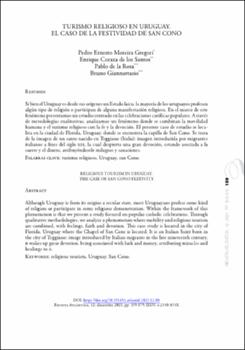Turismo religioso en Uruguay. El caso de la festividad de San Cono
Date
2021Abstract
Si bien el Uruguay es desde sus orígenes un Estado laico, la mayoría de los uruguayos profesan
algún tipo de religión o participan de alguna manifestación religiosa. En el marco de este
fenómeno presentamos un estudio centrado en las celebraciones católicas populares. A través
de metodologías cualitativas, analizamos un fenómeno donde se combinan la movilidad
humana y el turismo religioso con la fe y la devoción. El presente caso de estudio se loca-
liza en la ciudad de Florida, Uruguay, donde se encuentra la capilla de San Cono. Se trata
de la imagen de un santo nacido en Teggiano (Italia): imagen introducida por migrantes
italianos a fines del siglo xix, la cual despierta una gran devoción, estando asociada a la
suerte y el dinero, atribuyéndosele milagros y sanaciones. Although Uruguay is from its origins a secular state, most Uruguayans profess some kind
of religion or participate in some religious demonstration. Within the framework of this
phenomenon is that we present a study focused on popular catholic celebrations. Through
qualitative methodologies, we analyze a phenomenon where mobility and religious tourism
are combined, with feelings, faith and devotion. This case study is located in the city of
Florida, Uruguay where the Chapel of San Cone is located. It is an Italian Saint born in
the city of Teggiano: image introduced by Italian migrants in the late nineteenth century,
it wakes up great devotion, being associated with luck and money, attributing miracles and
healings to it.





